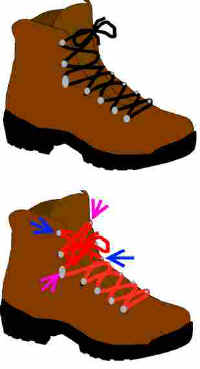|
Boots

Footwear suitable for walking comes in many forms.
Trainers are ok for gentle strolls but are usually not waterproof,
although if you are prepared to pay enough, GORE-TEX trainers are
available. Walking shoes
are better but if you are venturing on to rougher ground and especially on
to the fells/hills, boots are most strongly recommended.
They provide support to the ankle, give better grip,
keep your feet dry and reduce the feeling from sharp stones beneath your
feet.
Buy a reputable make from a reputable outdoor
supplier, not a fashion outlet which might sell a walking boot look-alike.
Wear your normal walking socks when trying them on.
Feet swell during the day
so buy in the afternoons if you can.
Now which boots to buy. Buy the best you can afford
but fit and comfort are most important. You will have them on most of the
day after all. If money is tight buy reasonably priced but proper walking
boots. They should still give support and be reasonably waterproof. Any
boots are likely to be better for the purpose than trainers.
It is worth having lighter weight fabric (but
waterproof) boots for summer use in dryer, relatively gentle conditions.
These will usually have GORE-TEX or similar breathable material. However for
winter or walking in rough stony terrain, leather boots are recommended.
If money is tight, go for cheap leather boots rather than fabric and
waterproof regularly.
Two season boots are lighter weight and suitable for
most late spring/summer/early autumn walking. Three season boots are more
rugged and suitable for most things except extreme winter walking. Better
quality (including leather) boots have GORE-TEX lining to really keep your
feet dry.
Three season boots will probably have stiffening and
be suitable for crampons of the right sort.
It is worth mentioning that
there is a
boot and crampon grading system as follows:
B0 Boots - more flexible - unsuitable for crampons.
B1 Hillwalking/hiking Boots - provide sufficient
performance to be used in winter hill conditions with caution - suitable
for crampons grade C1 (flexible with strap attachment)
B2 Mountaineering Boots - for winter walking/glacier
traverse - suitable for crampons grade C2 (articulated crampons with
straps or strapped front and clip-on heel)
B3 Climbing and mountaineering boots - fully
stiffened soles - suitable for articulated or fully stiffened crampons
with strap or clip-on systems.
B3 boots can take C1 or C2 crampons.
Boots need to have sufficient space at the front so
that toes do not stub on downhill descents.Try to find an outlet which has
a slope arrangement so you can try them in a "downhill mode" to
check this.
Look after your boots. Clean immediately after use.
If wet (either from the fells or scrubbing clean), stuff with newspaper to
absorb the moisture and if possible put in a well ventilated place. Do not
dry close to a source of heat as leather boots especially will eventually
crack. Waterproofing should be periodically applied in accordance with the
manufactures instructions. It may be worth buying some when you buy the
boots as the retailer might be persuaded to throw it in as part of the
deal. If the boot manufacturer produces a specific cream/wax for their
boot, use this as it will have been specially formulated.

How to tie Walking Boots
A word on
tying walking boots. The top of the two pictures on the right shows the
typical way in which a boot is tied. Laces are crisscrossed alternately
and tied in a bow across the top set of lugs. Some
people and/or with some boots find the tight band which results across the
top of the boot uncomfortable when the foot tries to bend on walking. An
alternative method is shown in the lower picture and is one I use. The laces are
crisscrossed in the normal manner until the third set of lugs from the
top. They are then crisscrossed directly from the third set to the top
(blue to blue and lilac to lilac arrows as shown) then crossed back to the
second set of lugs and tied there. This allows a little more give across
the top.
And the last word on
boots is really a safety issue. Some laces on boots are quite long so that
when tied in a bow, even a double bow, a large loop results. It is very
easy for this loop to catch in the lugs on the opposite boot as you walk
resulting in a very unexpected and incredibly fast headlong meeting with
the ground (as my wife can testify - and it hurts - she got the cuts and
bruises to prove it!!!). Either shorten the laces, tie them in a triple
or even quadruple bow to keep the loops small or tuck them in
somehow. Maybe go round the lugs a couple of times if the laces will
fit.
Visit the Happy Hiker
Hiking
Store to buy boots.
All
information on this site is given in good faith and no liability is
accepted in respect of any damage, loss or injury which might result from
acting on it.
|
